It’s been a tale of two different seasons for Michael Kopech, and due to the knee injury he suffered in mid-June, we’ve been provided an easy place to split the season up.
- April – June 12: 51.2 IP, 1.92 ERA, 3.10 FIP, 25.2 K%, 11.9 BB%, .136 BAA
- June 19 – Sept 13: 67.2 IP, 5.19 ERA, 5.57 FIP, 18.5 K%, 11.3 BB%, .241 BAA
Even if you use the mantra of “ERA tends towards a player’s FIP,” even the most pessimistic of estimators didn’t see the drop-off in Kopech’s season to where it’s been recently. He’s struggled with the home run ball (from 2.9% HR/FB pre-June 19 to 14.3% HR/FB since June 19), and a decrease in fastball velocity from an average of 95.4 mph to 94.5 mph has placed extra pressure on both Kopech’s command and offspeed pitches. The nearly similar 11% walk rates leave plenty to be desired, which places the emphasis solely on Kopech’s offspeed pitches. While he does feature a curveball that he throws about 10% of the time, his main offspeed pitch – which he throws about 27% of the time – is his slider.
Michael Kopech’s 2021 slider, by all accounts, was a “plus” pitch. With a 36% Whiff Rate, he found himself in a position to build and even lean on his slider while his other pitches continued to develop.
…Except, this season, we haven’t really seen that same slider, and should Kopech want to remain effective, he’s going to need to make some changes.
In order to get an understanding of why Kopech’s slider needs some improvements, it’s important to understand how the pitch has changed year over year. When observing the statistical results on his slider from 2021 to 2022, the differences are clear – though, at first glance, can partially be chalked up to a pitcher learning how to be a starter while battling a knee injury.
It’s the spin and whiff rate numbers, however, that really raise an eyebrow and start to tell the story of what has changed this season.
| Year | BA | xBA | wOBA | xwOBA | Spin | Whiff% |
|---|---|---|---|---|---|---|
| 2021 | .193 | .177 | .241 | .255 | 2465 | 36.0% |
| 2022 | .230 | .241 | .302 | .316 | 2389 | 21.3% |
Usually, a change of about 100 RPMs in spin rate is nothing to sound alarm bells over. However, when it’s accompanied by a drastic drop in whiff rate and worse results, it signals a change in: (a) how the pitch is moving, (b) how batters are viewing it, or (c) a combination of both.
Just a cursory glance at Kopech’s curveball from 2021 to 2022 shows a pitch that has lost some of its horizontal movement without making up for it via increased vertical movement.
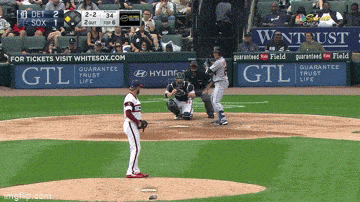
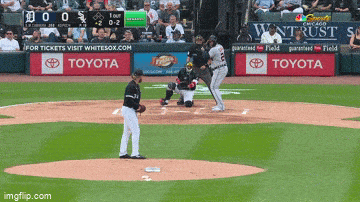
The still frame images, while not perfectly from the same angle, show pitches that start in two completely different places, only to end up in (relatively) the same position. The 2021 Kopech slider starts well within the zone and carries out of the zone. The 2022 slider hangs around the outside corner and falls out of the zone.
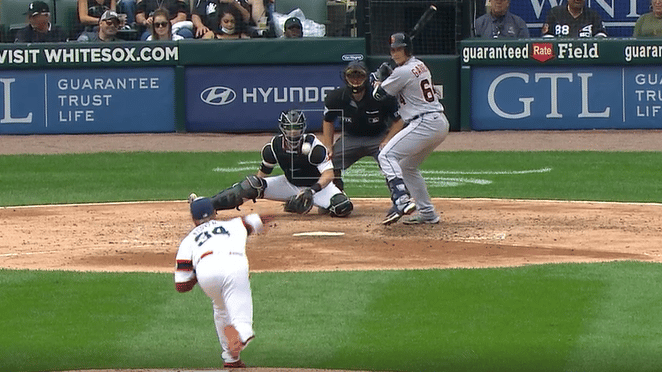
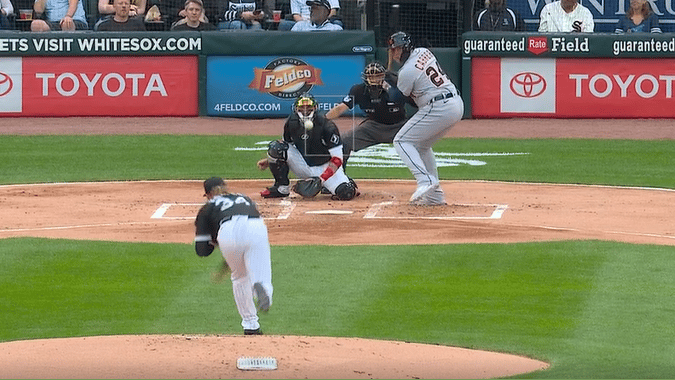
While these aren’t necessarily Kopech’s two best sliders, the numbers back up what the video shows: it’s the curious case of Michael Kopech and the two different sliders. The first slider (2021) has a lot of vertical AND horizontal movement. The second slider (2022) has a similar amount of vertical movement as his first, but nearly 50% less horizontal movement on average.
| Year | Vert. Drop (in.) | Vert. Drop (vs. Avg) | Horiz. Drop (in.) | Horiz. Drop (vs. Avg) |
|---|---|---|---|---|
| 2021 | 39.3 | 2.0 | 9.2 | 2.7 |
| 2022 | 40.2 | 3.1 | 4.7 | -2.5 |
When looking at this from a game-by-game basis over the past two seasons, two things pop out:
- The difference in movement from 2021 to 2022. The highs and lows are drastic, obviously, but the trends are visible
- Kopech’s change in slider appears to be an in-season change that occurred following three April starts
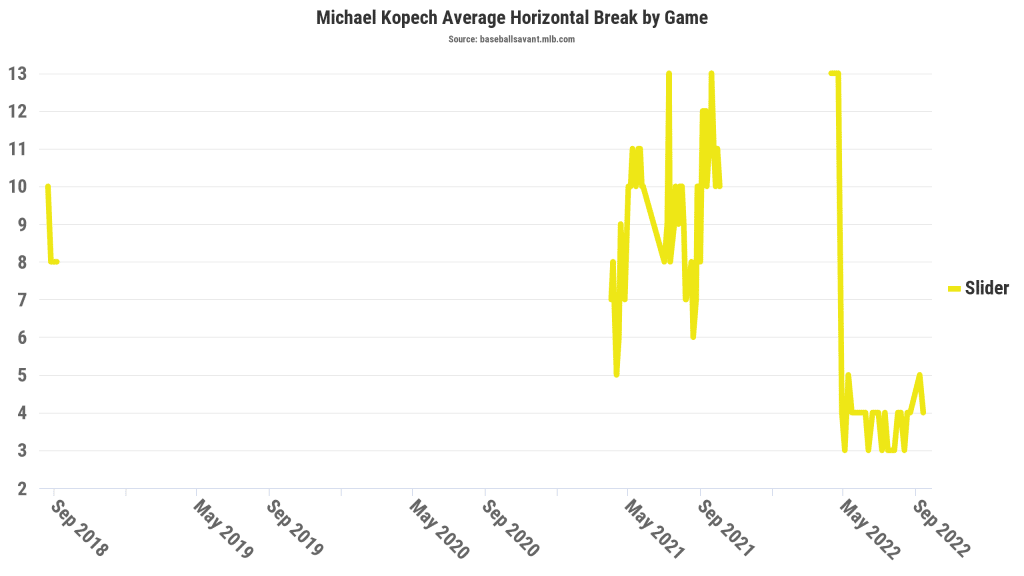
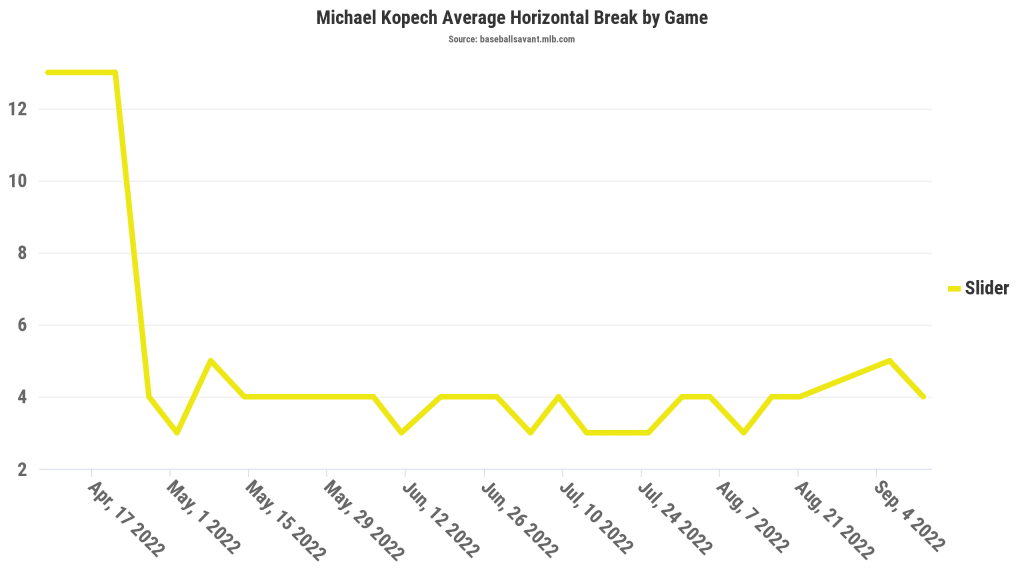
Kopech’s also opted for a faster version of his slider throughout the year. In his first three starts, his slider averaged 82.7 mph. Since then, it’s averaged 84.6 mph – a significant change when combined with all of the information above. It was accompanied by a slight change in release point – at least horizontally – and a lot less consistency overall in release point. Only Kopech himself would know if this has been enough of a change to make a significant impact, and while it’s an incredibly slight difference, it’s worth pointing out.
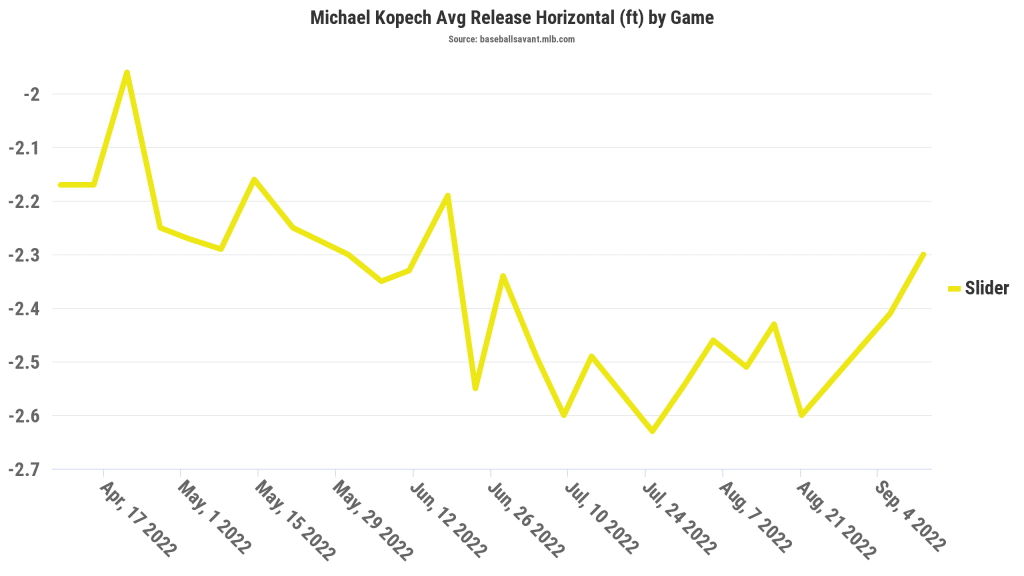
Interestingly, this change in slider shape is a move we’ve seen this season as well from Dylan Cease, who mentioned that he re-shaped his slider mid-season. Indeed, as we see Cease’s starts go on, we see more vertical movement and less horizontal movement.
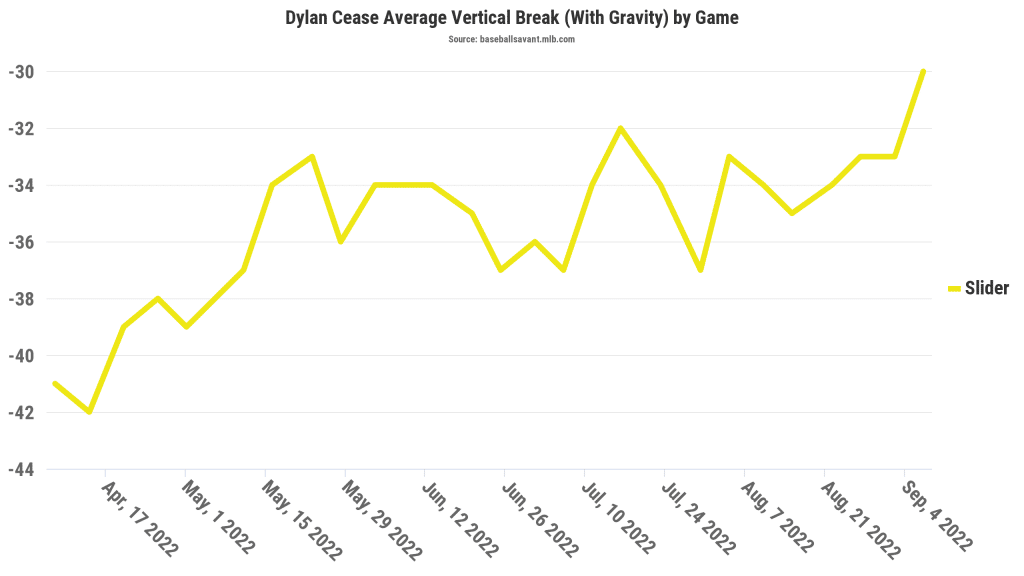
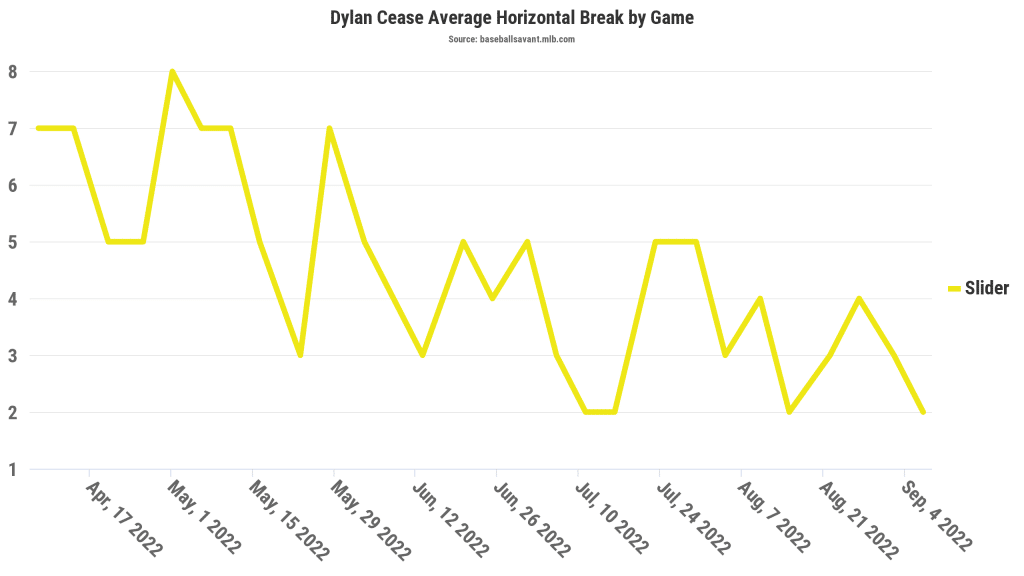
Seeing a trend between pitchers on a pitching staff certainly starts to trace back to the pitching coach, though this doesn’t nearly confirm a one-size-fits-all strategy that may be insinuated given the above comparison. What it does suggest, however, is a fully conscious attempt to unlock a new level in Kopech’s performance that just hasn’t worked out as anticipated. Perhaps it’s a change that hasn’t worked because of the difference in arsenals between Cease and Kopech. For example, it helps that Cease’s slider is 5-6 mph faster than Kopech’s while also coming out of a drastically different arm slot. Alternatively, perhaps learning a new slider shape on the fly mid-season is a lot more difficult on Kopech, who is still just learning how to work through the ups and downs as a starting pitcher in the first place. Perhaps it’s a bit of both – though, no matter what it is, it’s clear that the results have not seen a return to 2021 levels since the noticeable change in slider shape.
| Start # | BA (xBA) | SLG (xSLG) | wOBA (xwOBA) | Spin Rate | Whiff% |
|---|---|---|---|---|---|
| First 3 GS | .500 (.104) | .750 (.135) | .567 (.221) | 2408 | 18.7% |
| Last 22 GS | .222 (.245) | .407 (.434) | .293 (.319) | 2387 | 21.5% |
The obvious question from the above is: “if his slider before the change was so good, why didn’t the early season results match his 2021 season?” A three-game sample size isn’t much to work with, but the above shows perhaps an overreaction to early-season results, despite the fact that the expected statistics(xBA, xSLG) were much more in-line with Kopech’s 2021 results. In any event, the chance hasn’t led to a significant improvement in Kopech’s Whiff Rate back to 2021 levels, leaving him an area of opportunity for 2023 growth.
Michael Kopech isn’t going to become a front-of-the-rotation starter overnight, nor should that be the expectation. Recognizing an area for improvement in pitch design is not only likely, but expected as young arms learn how to become true “pitchers” in the major leagues. Should Kopech find himself questioning this, he need look no further than rotation-mates Lucas Giolito and Dylan Cease.
Arguably, re-shaping his slider isn’t even the most important change for Kopech to make heading into next season. With 88.6% of his pitches being either a fastball (61.8%) or slider (26.8%), Kopech has placed too much trust into two good-but-not-elite pitches throughout the season. One path for Kopech is to develop a Cease-like offering that makes a claim for the best single pitch in baseball so that he can more comfortably rely on two pitches. Given that’s a tall task, until then, Michael Kopech is going to have to develop a third – and likely fourth – pitch over the offseason as he looks to take that next step and give hitters something else to think about in the box. Hitters will too easily dismiss his curveball and changeup if he doesn’t command and use them at a higher level.
The White Sox’s chances of making the 2022 playoffs likely don’t come down to whether Michael Kopech can re-discover what made his slider so effective in 2021. However, with questions marks surrounding at least one rotation spot in 2023 – and potentially two, should Lucas Giolito not return to form – the pressure incurred on Dylan Cease and a 36-year-old Lance Lynn doesn’t necessarily line up with “World Series or bust” vibes next year. It will require players who have been billed as key to the rebuild to unlock a window of extended contention.
Kopech has put himself in a position, like Dylan Cease before him, to be a mainstay in the rotation with three more years of control on his rookie contract. In order to do that effectively, he and pitching coach Ethan Katz will need to go back to the drawing board this offseason to unlock whatever the next gear may be for Kopech.
Perhaps they can start with the once well-above-average offering and turn it into an elite one.
Follow us @SoxOn35th for more updates throughout the season!
Featured Image: Lindsey Wasson-USA TODAY Sports
"some" - Google News
September 16, 2022 at 09:54PM
https://ift.tt/UvdSlR1
Michael Kopech's slider isn't bad, but it needs some re-shaping - Sox On 35th
"some" - Google News
https://ift.tt/QweUxm5
Shoes Man Tutorial
Pos News Update
Meme Update
Korean Entertainment News
Japan News Update
Bagikan Berita Ini














0 Response to "Michael Kopech's slider isn't bad, but it needs some re-shaping - Sox On 35th"
Post a Comment